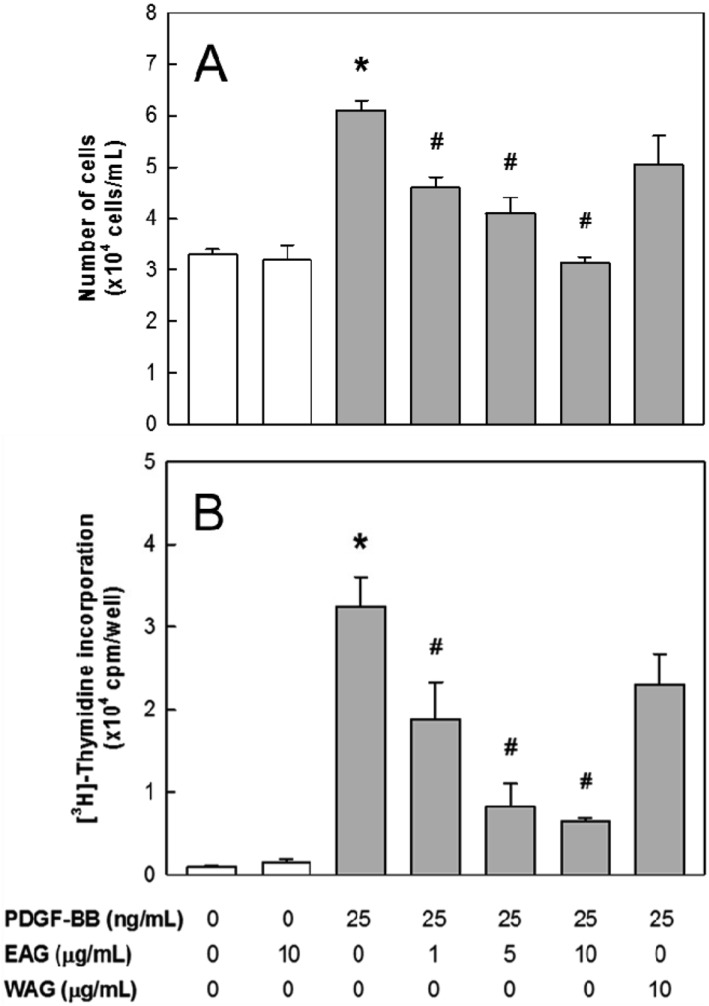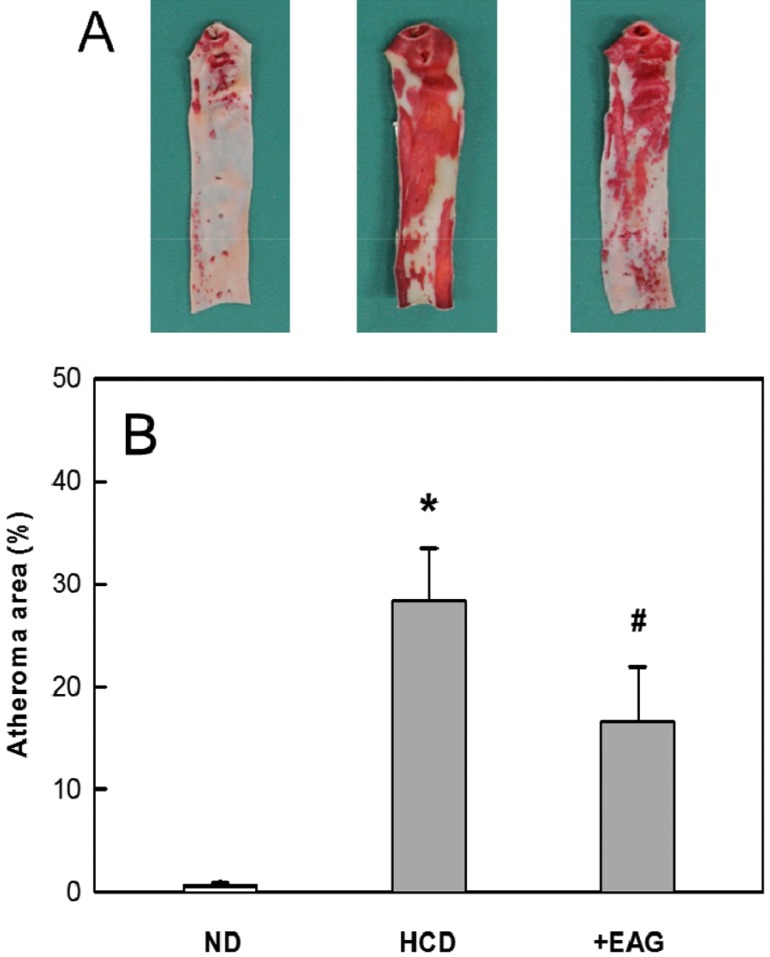Lab Anim Res.
2014 Jun;30(2):84-89. 10.5625/lar.2014.30.2.84.
An ethanolic extract of Angelica gigas improves atherosclerosis by inhibiting vascular smooth muscle cell proliferation
- Affiliations
-
- 1College of Veterinary Medicine, Chungbuk National University, Cheongju, Korea. solar93@cbu.ac.kr, vertebrate@hanmail.net
- 2Misuba RTech Co., Ltd., Asan, Korea.
- 3Daejeon Health Sciences College, Daejeon, Korea.
- KMID: 1707448
- DOI: http://doi.org/10.5625/lar.2014.30.2.84
Abstract
- The effects of an ethanolic extract of Angelica gigas (EAG) on the vascular smooth muscle cell (VSMC) proliferation and high-cholesterol diet-induced hypercholesterolemia and atherosclerosis were investigated. Rat aortic VSMCs were stimulated with platelet-derived growth factor-BB (25 ng/mL) for the induction of DNA synthesis and cell proliferation. EAG (1-10 microg/mL) significantly inhibited both the thymidine incorporation and cell proliferation in a concentration-dependent manner. Hypercholesterolemia was induced by feeding male New Zealand white rabbits with 0.5% cholesterol in diet for 10 weeks, during which EAG (1% in diet) was given for the final 8 weeks after 2-week induction of hypercholesterolemia. Hypercholesterolemic rabbits exhibited great increases in serum total cholesterol and low-density lipoproteins (LDL) levels, and finally severe atheromatous plaque formation covering 28.4% of the arterial walls. EAG significantly increased high-density lipoproteins (HDL), slightly decreased LDL, and potentially reduced the atheroma area to 16.6%. The results indicate that EAG attenuates atherosclerosis not only by inhibiting VASC proliferation, but also by increasing blood HDL levels. Therefore, it is suggested that EAG could be an alternative or an adjunct therapy for the improvement of hypercholesterolemia and atherosclerosis.
Keyword
MeSH Terms
Figure
Reference
-
1. Huh KB. The present status of nutrition-related diseases and its countermeasures. Korean J Nutr. 1990; 23(3):197–207.2. Lee HK. Pattern of disease incidence and nutrition in Korea. Korean J Nutr. 1996; 29(4):381–383.3. Lee YC. Hypercholesterolemia in Korea and nutritional factors. Korean J Lipidol. 1991; 1(1):111–122.4. Spady DK, Woollett LA, Dietschy JM. Regulation of plasma LDL-cholesterol levels by dietary cholesterol and fatty acids. Annu Rev Nutr. 1993; 13:355–381. PMID: 8369151.5. Natio HK. Atherogenesis: current topics on etiology and risk factors. Clin Chem. 1995; 41:132–133.6. Keys A. Coronary heart disease in seven countries. Circulation. 1970; 41:1–11.
Article7. Kannel WB, Castelli WP, Gordon T, McNamara PM. Serum cholesterol, lipoproteins, and the risk of coronary heart disease. The Framingham study. Ann Intern Med. 1971; 74(1):1–12. PMID: 5539274.8. Bae HY. The role of oxidized low density lipoprotein in atherogenesis. J Korean Diabetes Assoc. 1999; 23:7–11.9. Glass CK, Witztum JL. Atherosclerosis: The road ahead. Cell. 2001; 104:503–516. PMID: 11239408.10. Ross R. Mechanisms of atherosclerosis--a review. Adv Nephrol Necker Hosp. 1990; 19:79–86. PMID: 2105588.11. Dzau VJ, Braun-Dullaeus RC, Sedding DG. Vascular proliferation and atherosclerosis: new perspectives and therapeutic strategies. Nat Med. 2002; 8(11):1249–1256. PMID: 12411952.
Article12. Sachinidis A, Locher R, Hoppe J, Vetter W. The platelet-derived growth factor isomers, PDGF-AA, PDGF-AB and PDGF-BB, induce contraction of vascular smooth muscle cells by different intracellular mechanisms. FEBS Lett. 1990; 275(1-2):95–98. PMID: 2262007.
Article13. Blenis J. Signal transduction via the MAP kinases: proceed at your own RSK. Proc Natl Acad Sci U S A. 1993; 90(13):5889–5892. PMID: 8392180.
Article14. Heldin CH, Ostman A, Rönnstrand L. Signal transduction via platelet-derived growth factor receptors. Biochim Biophys Acta. 1998; 1378(1):F79–F113. PMID: 9739761.
Article15. Ahn HY, Hadizadeh KR, Seul C, Yun YP, Vetter H, Sachinidis A. Epigallocathechin-3 gallate selectively inhibits the PDGF-BB-induced intracellular signaling transduction pathway in vascular smooth muscle cells and inhibits transformation of sis-transfected NIH 3T3 fibroblasts and human glioblastoma cells (A172). Mol Biol Cell. 1999; 10(4):1093–1104. PMID: 10198059.16. Blum A, Simsolo C, Hasin Y. 3-Hydroxy-3-methylglutaryl coenzyme a (HMG-CoA) reductase inhibitors (statins), atherosclerosis and coronary syndromes. Atherosclerosis. 2004; 175(1):1–5. PMID: 15186940.
Article17. Larsen ML, Illingworth DR. Drug treatment of dyslipoproteinemia. Med Clin North Am. 1994; 78(1):225–245. PMID: 8283933.
Article18. Cho JH, Lee NJ, Chai HY, Kim TM, Park JH, Kang JK, Kim YB, Hwang SY. Effect of Hwalgidan SJ-101 on atherosclerosis in hypercholesterolemic rabbits. Lab Anim Res. 2005; 21:149–158.19. Hong SH, Chai HY, Kim TM, Lee NJ, Kim DK, Cho JH, Park JH, Kim YB, Kang JK, Hwang SY. Therapeutic effects of mulberry root-bark (Mori radicis Cortex) ethanol-extracts on atherosclerosis in hypercholesterolemic rabbits. Lab Anim Res. 2005; 21:273–279.20. Jung DS, Porzel A, Huneck S. Gigasol and other coumarins isolated from Angelica gigas. Phytochemistry. 1991; 30:710–712.21. Chi HJ, Kim HS. Studies on the components of Umbelliferae plants in Korea: Pharmacological study of decursin, decursinol, and nodakenin. Korean J Pharmacogn. 1970; 1:25–32.22. Kang SY, Lee KY, Park MJ, Kim YC, Markelonis GJ, Oh TH, Kim YC. Decursin from Angelica gigas mitigates amnesia induced by scopolamine in mice. Neurobiol Learn Mem. 2003; 79(1):11–18. PMID: 12482674.
Article23. Lee JK, Choi SS, Lee HK, Han KJ, Han EJ, Suh HW. Effects of ginsenoside Rd and decursinol on the neurotoxic responses induced by kainic acid in mice. Planta Med. 2003; 69(3):230–234. PMID: 12677526.
Article24. Choi SS, Han KJ, Lee JK, Lee HK, Han EJ, Kim DH, Suh HW. Antinociceptive mechanisms of orally administered decursinol in the mouse. Life Sci. 2003; 73(4):471–485. PMID: 12759141.
Article25. Kim JH, Jeong JH, Jeon ST, Kim H, Ock J, Suk K, Kim SI, Song KS, Lee WH. Decursin inhibits induction of inflammatory mediators by blocking nuclear factor-kappaB activation in macrophages. Mol Pharmacol. 2006; 69(6):1783–1790. PMID: 16510559.26. Shin S, Jeon JH, Park D, Jang JY, Joo SS, Hwang BY, Choe SY, Kim YB. Anti-inflammatory effects of an ethanol extract of Angelica gigas in a Carrageenan-air pouch inflammation model. Exp Anim. 2009; 58(4):431–436. PMID: 19654443.
Article27. Shin S, Joo SS, Park D, Jeon JH, Kim TK, Kim JS, Park SK, Hwang BY, Kim YB. Ethanol extract of Angelica gigas inhibits croton oil-induced inflammation by suppressing the cyclooxygenase-prostaglandin pathway. J Vet Sci. 2010; 11(1):43–50. PMID: 20195064.28. Joo SS, Park D, Shin S, Jeon JH, Kim TK, Choi YJ, Lee SH, Kim JS, Park SK, Hwang BY, Lee do I, Kim YB. Anti-allergic effects and mechanisms of action of the ethanolic extract of Angelica gigas in dinitrofluorobenzene-induced inflammation models. Environ Toxicol Pharmacol. 2010; 30(2):127–133. PMID: 21787642.
Article29. Lee YY, Lee S, Jin JL, Yun-Choi HS. Platelet anti-aggregatory effects of coumarins from the roots of Angelica genuflexa and A. gigas. Arch Pharm Res. 2003; 26(9):723–726. PMID: 14560920.30. Chamley JH, Campbell GR, McConnell JD, Groschel-Stewart U. Comparisonof vascular smooth muscle cells from adult human, monkey and rabbit in primaryculture and in subculture. Cell Tissue Res. 1977; 177:503–522. PMID: 402216.
Article31. Lee JJ, Yu JY, Zhang WY, Kim TJ, Lim Y, Kwon JS, Kim DW, Myung CS, Yun YP. Inhibitory effect of fenofibrate on neointima hyperplasia via G(0)/G(1) arrest of cell proliferation. Eur J Pharmacol. 2011; 650(1):342–349. PMID: 21040719.
Article32. Park ES, Lee KP, Jung SH, Lee DY, Won KJ, Yun YP, Kim B. Compound K, an intestinal metabolite of ginsenosides, inhibits PDGF-BB-induced VSMC proliferation and migration through G1 arrest and attenuates neointimal hyperplasia after arterial injury. Atherosclerosis. 2013; 228(1):53–60. PMID: 23473423.
Article33. Kim JH, Jin YR, Park BS, Kim TJ, Kim SY, Lim Y, Hong JT, Yoo HS, Yun YP. Luteolin prevents PDGF-BB-induced proliferation of vascular smooth muscle cells by inhibition of PDGF beta-receptor phosphorylation. Biochem Pharmacol. 2005; 69(12):1715–1721. PMID: 15935146.34. Cheong SH, Kim MY, Sok DE, Hwang SY, Kim JH, Kim HR, Lee JH, Kim YB, Kim MR. Spirulina prevents atherosclerosis by reducing hypercholesterolemia in rabbits fed a high-cholesterol diet. J Nutr Sci Vitaminol (Tokyo). 2010; 56(1):34–40. PMID: 20354344.
Article35. Park D, Kyung J, Kim D, Hwang SY, Choi EK, Kim YB. Anti-hypercholesterolemic and anti-atherosclerotic effects of polarized-light therapy in rabbits fed a high-cholesterol diet. Lab Anim Res. 2012; 28(1):39–46. PMID: 22474473.
Article36. Ross R. Atherosclerosis is an inflammatory disease. Am Heart J. 1999; 138:S419–S420. PMID: 10539839.
Article37. Ross R. Atherosclerosis--an inflammatory disease. N Engl J Med. 1999; 340(2):115–126. PMID: 9887164.38. McClelland GA, Stubbs RJ, Fix JA, Pogany SA, Zentner GM. Enhancement of 3-hydroxy-3-methylglutaryl-coenzyme A (HMG-CoA) reductase inhibitor efficacy through administration of a controlled-porosity osmotic pump dosage form. Pharm Res. 1991; 8(7):873–876. PMID: 1924137.39. Yim JE, Choue RW, Kim YS. Effects of dietary counceling and HMG-CoA reductase inhibitor treatment on serum lipid levels in hyperlipidemic patients. Korean J Lipidol. 1998; 8(1):61–76.
- Full Text Links
- Actions
-
Cited
- CITED
-
- Close
- Share
- Similar articles
-
- In Vitro Culture of Endothelial Cell and Smooth Muscle Cell for Studying Vascular Diseases
- Roles of Vascular Smooth Muscle Cells in Atherosclerotic Calcification
- Effects of Ca2+ Channel Blockers on Expression of L-type Voltage Dependent Ca2+ Channels in Vascular Smooth Muscle Cells Obtained from the Aorta of Diabetic Rats
- The effect of advanced glycation and products on the proliferation of vascular smooth muscle cell
- Role of Cytosolic Calcium Ion and Expression of Proliferation Responsive Gene of Cultured Medial Smooth Muscle Cells Obtained from rat Aortas with Atherosclerotic Changes Induced by High Cholesterol Feeding




